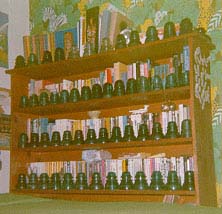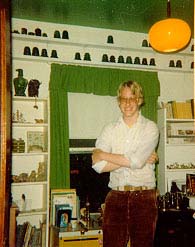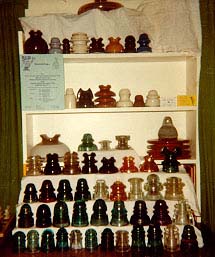History of a Collector
My First Time
 |
| My First Insulator |
|---|
I guess I was about 13 the first time it happened to me.I had a friend, Rex, whose
house I'd go over to after school. On the way home, his house was just before the
pedestrian bridge over the tracks. In fact, his backyard was right up against them.
I'd frequently stop there to play around, and every so often we'd see the trains go by.
I remember that particular day it was in the summer, early fall at most. It was a
great day. The sun was shining, the sky was blue, and we were
playing around with his BB gun. For some reason, on this day I noticed
a row of 4 or 5 of these glass things Rex had on his desk. A couple were green, the
rest were white. I didn't have any idea what they were then, but they looked neat.
In hindsight, I'm sure that they were all Hemi-42s and Armstrong DP1s. They made quite
an impression on me, since I obviously told my parents about them, but then I promptly
forgot all about them. That Christmas, they gave me a Hemingray-42 in aqua, with round
drip points. That's how it all started for me.
 |
| My First Find |
|---|
Actually, though, it didn't start until about 6 months later. I kept that first insulator
on my window sill all winter long, but didn't do that much with it other than admire it
occasionally. My father is a railroad buff -- we would frequently walk the tracks looking
for a good spot to sit and wait for the trains to go by so that he could take pictures of
them. At some point, he started to collect date nails (the nails driven into railroad
ties in order to indicate the date of installation, type of wood, and various other
characteristics), so we would always be keeping an
eye out for ones he didn't have on any of our hikes. One day in May, we were out on one
of these hikes, walking along what used to be the Buffalo, Rochester, and Pittsburgh
Railroad, when it happened. Looking for datenails, you usually walk with your head down
looking at the ties as you walk over them. I'd occasionally look around, and
I noticed that every pole we passed had a pile of insulators underneath it. Hundreds of
them, if not thousands, since this went on for miles. There was probably 10-20
insulators at each pole. It didn't take me long to go over and look, and then I went a
little crazy poking through them all, making little piles of my own with all the different
ones that I wanted. By the end of the day I had about 40-50 of them that I lugged back
to the car (my father and brother helped with that, thankfully!). I took them home and
arranged them around my bedroom, but mostly in the bookcase beside my bed. That was the
real beginning.
I spent most of that summer gathering more insulators, and coming up with various methods
of classifying them. I was most intrigued with the shapes that they came in. I gave them
all different names -- regular (CD 154), irregular (CD 155), bullet (CD 145), and wrote up paper
lists that had these shapes, their color and embossing, where I found them, and when.
 |
| Insulators from CMP |
|---|
That summer we went to Maine (my family has a cottage on Little Sebago Lake near
Portland), and I ended up talking with some fellows from CMP (Central Maine Power) who
were doing some work on the lines near where we had dinner one day. They invited me back
to the plant, and I jumped at the chance. They were all very friendly, and they ended up
giving me a small tour and a number of insulators, mostly porcelain, but a couple glass
-- including a CD 149 No Name that I just loved. They also gave me a very interesting
porcelain multipart that had the top covered with a film of copper.
I believe that it was in September of 1980 that I discovered the Crown Jewels of the Wire
magazine. My local library had a copy of N.R. Woodward's 1967 Glass Insulator Report, as
well as some of the Tibbett's books. I believe one or the other mentioned the magazine,
and I subscribed immediately. The first isssue that I got had an article on the Seldom
Seen display at the Hershey National. I really regretted not finding out about that until
just too late.
 |
| Bill, circa 1980 |
|---|
Also at about that time, my friend Bill Snell got interested in insulators. He and I
started trading stuff all the time. It was loads of fun. We found a lot of common stuff
at local antique shops and junk stores, as well as along the railroad lines, and we
never tired of trading them back and forth. All winter long we did that.
 |
| A Private Display |
|---|
Come spring, we discovered insulator show and sales. We went to the GVBCA (Genessee
Valley Bottle Collectors Association) Show and Sale, and it was there that we met the
insulator community. Soon we were going to many of the shows on a yearly basis -- the
GVBCA Show and Sale; the Capitol District Insulator Club (CDIC) Show and Sale; the Yankee
Pole Cat Insulator Club (YPCIC) Show and Sale; the Eastern Regional in Kulpsville, PA;
the London, Ohio Show and Sale; and various other local bottle shows, swap meets, and
the like.
Over time, both Bill and I decided to specialize our collections. I came to the
realization that I had accumulated about 500 insulators, and many of them were very
similar. The thing that intrigued me the most were the varieties of shapes -- so that is
what I decided to keep. I kept one of every different shape that I had, along with a
variety of different manufacturers, colors, and ones that were special to me for some
reason, and eliminated all the rest. I didn't eliminate them, really. I moved most of
them out into the garage in a big box, which is now buried in my basement somewhere.
Some of them I actually did throw out, but not too many.
I continued going to shows and buying pieces, picking some up through the mail and however,
until eventually I reached a point where I wasn't getting too many new insulators. My
collection -- I was only getting the Integral CD Numbers -- was almost complete. The only
ones that I needed were rare, and not only were they not sold that often, but when they
were they commanded prices that were out of my reach. I gradually lost interest in
insulators for a while, and didn't go to so many shows or even worry about it.
My boredom didn't last too long, though. I realized what was happening, and liked
insulators enough to realize that what I needed was a new interest area. So I decided
to expand my collection. The most obvious thing to do was to start getting the points,
so I immediately started to do that. I also took careful stock of what I really was
interested in, and decided that there were two other areas that really interested me:
1) the different manufacturers; and 2) insulator patents. Just as I would like to get
one of each of the different shapes, I'd rather like to get at least one of each of
the different manufacturers, maybe also of each of the major embossing variations that
they used. And I'm fascinated by the research and development that went into insulators,
as evidenced by the large number of insulator patents.
I currently have several main collections -- Integral CDs, CD Points, French, Manufacturers,
and Patents.
In addition to those collections, I have a number of insulators from foreign countries
(Spain, Germany, Australia, England and Japan, mainly), and a nice selection of color
insulators that I have kept.





